Feature Interview with Masa Nishijima August 2007
Since 1989, Masa Nishijima has written for a variety of Japanese golf publications and has served as a design consultant for courses in Asia. He is the author of the award-winning book Analysis of a Golf Course, which was released in Japan in 2005. Masa was the sixth person to play all the courses listed on GOLF Magazine’s World Top 100 List. He is also a panelist for that same ranking.
How did you get into golf course architecture?
Please understand that I am not a golf course architect. I am a course commentator, consultant & advisor to renovation. In regards to constructing a golf course, though, I have learned the most from my friend Tom Doak. Also I learned some from Jim Urbina in regards to how to create things, as well as from Pete Dye and his family. I learned the design theories behind their golf courses without ever aiming to be a golf course designer. Rather, I have inspected 1800 courses around the world in 45 countries. Therefore the knowledge that I have gained from such men and from such travel is most useful when it comes time for me to advise on course renovation and redesign.
Which of Alison’s designs in Japan remain the most authentic?
To answer this question properly is a very long explanation as there is a big misunderstanding about Alison’s work in Japan.
I need to introduce those who actually built the courses for Alison. They are Komyo Otani, Shiro & Rokuro Akaboshi, Kinya Fujita, and Chozo Ito.
About Tokyo GC Asaka Course (No longer in existence)
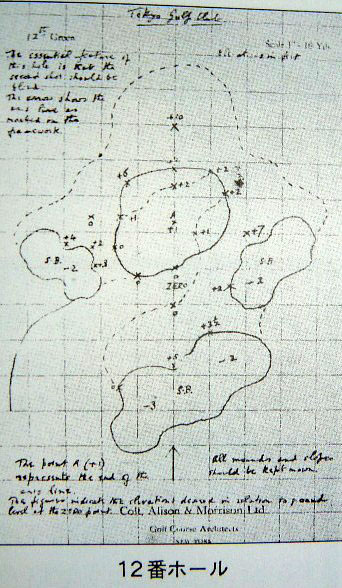
Alison’s sketch of the twelfth at the Asaka course. (Photo by Tokyo GC 1932)
Alison came for the design of Tokyo GC Asaka course in 1930. He actually arrived not from Britain at that time but from the United States and brought with him Penglace, who was his shaper & foreman in the United States. After Alison returned home, the Tokyo Asaka course was built under the direction of Penglace.
Tokyo Asaka Course was a U.S. Classic Parkland type rather than the courses that Harry Colt of Britain built in the U.K.
About Hirono
Mr. Chozo Ito of Hirono took guidance from Penglace at Tokyo GC and became the foreman at Hirono. Ito related to drawings by Alison to images of noble British and American courses. Fragrances of British heathland as well as US Classic type such as Pine Valley were mixed in at Hirono. The greens were on a grand level like those of Alister Mackenzie! Unfortunately, Hirono was used for an air force runway in the middle of war. After the war, the course was a burnt field and many trees were planted. The current course was restored by Mr Inue and Osamu Ueda based on Alison’s original drawings. However, trees disturbed the width of the fairways, and the fairways became small, and it was restored as a Parkland type with British Colt’s work as a model. The current Hirono has many plateau greens.

The rugged and heroic fifth at Hirono. (Photo by Seiichiro Takahata 1932)
The thirteenth of Hirono was a par three which included a bunker in the middle of the green ala the sixth at Riviera. After the war, it was not restored as Alison originally had it. In addition, today’s twelfth green is not an Alison original but was added later to extend distance.
About Kawana
The drawing reached Japan in 1932 from Alison but construction didn’t start until 1934. Komyo Otani took charge as Foreman. However, Otani encounters a big problem here: the bentgrass of Tokyo Asaka was proving not to be a good match in Japan and its management cost was immense.
Thus, Otani chose korai grass. However, Alison’s drawings were contoured for bent greens and the contouring of the greens with the different grass did not come easy to him. Furthermore, Kawana collides with a big problem. Alison had crossing fairways at number thirteen and fourteen. Given the Japanese golfer’s level of understanding at the time, Otani felt this was a very real danger. Thus, he created the tee box for fourteen at its present position. Unfortunately, the new teeing ground of fourteen was near the fairway of the ninth, so he repositioned the ninth fairway also.
Because Kawana was public, no one thought there was a club history book. Nine years ago, however, an original drawing by Alison was discovered. I was always curious about the very large land between the eleventh fairway and the thirteenth fairway. Comparing the original drawing and the current fourteenth hole, I discovered unevenness in the topography, which was the tee box, whereby the fourteenth fairway would have crossed the thirteenth.
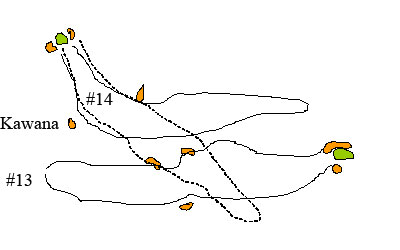
The outlined fairway shows the fourteenth fairway as Alison designed it and the solid line shows how Otani built it.
As for the bunkers of Kawana, Otani had made the bunker at the Tokyo Asaka Cse and made them according here to Alison’s drawing. Therefore, the bunkering at Kawana is original today to how Alison intended.
Shiro & Rokuro Akaboshi designed and converted Abiko GC, which was their Home Course using Tokyo Asaka Course as their model. Alternate Greens were later added by Seiichi Inoue.
Alison is one of the master architects of all-time. Given that, have any of the Japanese clubs that proudly possess one of his courses ever sought to do a full restoration?
Japanese misunderstand the design theory of Alison. The greatest present that Alison brought to Japan was in landscaping and routing eighteen holes. However, most Japanese associate the angled plateau green and sand flash of deep bunkers like British Harry Colt as Alison’s main contribution.
However, it was the ground level green that Alison described and that are found in original drawings of Hirono. The creation method of both bunkers & greens at Hirono conveyed a method same as Mackenzie.
Conversely, the shaping by Penglace in Tokyo GC Asaka Course resembled a design of C.B Macdonald and Seth Raynor.
Alison always worked with the land and changed the design of cross bunkers and fairway bunkers to be characteristic of the land. For example, Hirono used sand flash type whereas Tokyo GC and Kawana were mainly grass faced type.
My dream is to see Kawana and Hirono restored to their original state based on Alison’s drawings. The architect who can enable this does not live in Japan. An American like Tom Doak or Coore/Crenshaw could make this dream a possibility as much delicate work will be demanded.

The second at Hirono, in its original splendour with plenty of width. (Photo by Seiichiro Takahata 1932)
How many of Alison’s famous courses in Japan feature double greens?
Hirono GC has always featured one green from when it was established. Kawana restored its greens for the World Amateur Cup in 1960. While they were doing that, they made temporary greens to enable guest play to continue. Several of these temporary greens became alternate greens as found on holes nine, ten and twelve. Otherwise, Kawana has single greens.
What is the purpose of the famous Japanese double greens?
The reasons for the Alternate Greens are rainfall and high temperature humidity. Also, Japan has struggled with proper management of its grasses. Japan needed Winter Green (Bent) and Summer Green (Korai) for a long time. Unfortunately, a lot of two green courses were renovated with Korai Green in Bent Green, and courses with two Bent Greens (Pencross & Pen A-1) recently increased in Japan.
I need to explain this. Seiichi Inoue promoted two greens in Japan on his designs after the war. His theory had meaning with another climate. Since courses were being built on small lots with narrow fairway width, giving two routes to approach delighted members. I agree some with this thought. A golf course must have some capture routes in its tee shot. If that is impossible because a site is narrow, I think that the approach of two greens may add variety.

How can two green sites relatively near one another look natural?
There are three types. One is a hole where two greens are located in a line. This cannot be evaluated. The second is a hole where the distance of approach to two greens differs. The evaluation cannot do this highly, either. The third is a hole where the route to two greens is divided into two. This deserves evaluation. For example, par three of Tokyo GC number twelve has the tee box in a different place, and it is not evident that it is a twin green.
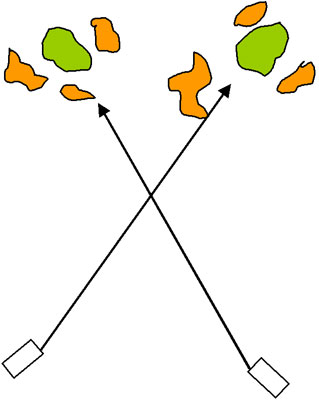
The dual-green twelfth at Tokyo GC.
Please tell us about Tokyo GC’s move during the War.
The Tokyo GC-Asaka course built by Alison was confiscated by the army in 1938, and was lost. It transferred to its present location in 1940. Komyo Otani designed a new course using the Asaka course as the model. Seiichi Inoue changed it into Alternate Greens (Twin Greens) in 1960, which is how it is today.
The army gave an order to Tokyo GC and Kasumigaseki CC in war-time 1945 to make an airfield at the golf course. Japan had food shortage in those days.
My grandfather was the colonel who commanded an air force (the air force belonged to the navy in Japan) at the nearby Hidaka base. My grandfather ignored the order of the army.
My grandfather wanted to show to the United States Armed Forces airplanes that Japan was still strong. So he made model airplanes of wood about seven feet long made away from the golf courses. Then he ordered that glass be put on the models. When seen from above, the optical reflection in the sky made them look like huge fighters. The air force then centralized their B-29 bombings here, away from the golf courses.
If not for my grandfather’s idea of model airplanes and ignoring an order of the army, two of Japan’s greatest golf courses would have been lost. I found all this out in his diary when he died at 90 years old.
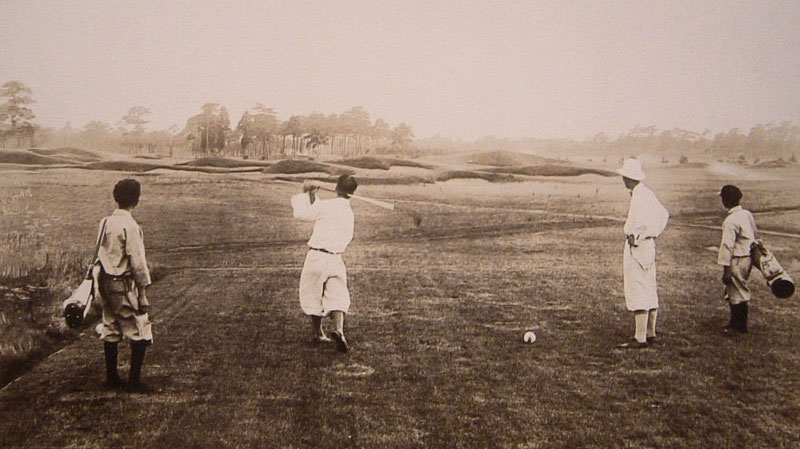
The second at Tokyo’s Asaka course. (Photo by Tokyo GC 1932)
How hard is it for an overseas visitor to come play several Alison courses in Japan.
Kawana is public so play is quite possible. Hirono requires a member as a playing companion. However, members of Hirono are often quite generous to foreign guests. You can send a letter to the Club with your HDCP and your own club affiliation several months before you plan to visit. Also, try to play both Kasumigaseki and Naruo, where Alison advised on re-designs. They are tolerant too of overseas guests.
Please discuss Japanese culture vis-Ã -vis tree planting and tree clearing.
Thank you for the wonderful question. Japanese people prize trees too much. Pine trees grow immediately and greatly. However, it seems that Japanese people ask trees to provide traditional beauty to the course. Only in Japan is a golfer likely to find a tree planted in the middle of a fairway. There is a hazard called a wind in space and we don’t need trees to provide another hazard in space. The numerousness of trees narrows a golf course as well as hindering routes in playing a hole. Moreover, sunlight hours are interrupted, making course condition worse.
What is your favorite course built in Japan after 1960? What do you like so much
about it?
After 1960? Unfortunately there is nothing. There are many golf courses where the condition of land was not suitable for golf. If the question was after 1950, then my answer would be Koga, Ono, Hakone. Hakone CC where I consult is a layout on a very large site and with good terrain. The old top player Shiro Akaboshi designed the original. He studied in U.S.A. during the 1910-1920 time frame and learned golf and classic golf course architecture from Macdonald and Ross. When Alison visited Japan, he accompanied him as an interpreter and learned further about golf course design. A Japanese architect redesigned the greens here at Hakone CC ten years ago, but he made a mistake by not appreciating classic design concept. Therefore, a club committee sought advice from me. However, green remodeling is nearly impossible. I felled 1,000 trees and returned the course to its scale from the 1950’s. I also improved the rough, bunkering and fairway lines. We are a few years away from completion.
What challenges were faced in golf development during the 1980s in Japan?
The American course designer faced the most hardship, with both the land and owners (who are not course designers) who desired impossible things in Japan. The owners wanted to imitate the famous courses that the Japanese people had seen in the United States and England, asking for ‘Amen Corner at Augusta National’, ‘TPC Sawgrass’, ‘Pebble Beach’ etc even though the land did not allow for them.
In the 1980’s the Japanese land was too small scale to build American modern designs or links style. Also, Japanese owners did not want hard contours in the green because they thought it caused slow play.
I advised on the renovation of a course that Michael Poellet designed in Japan three years ago. However, it was not the course that Michael had originally designed, and when I cam in, I thought Michael’s original design made the most sense. The owners had put a tree in the fairway and replaced rough with fairway, got rid of bunkers and renovated his design before I visited.
The 1980’s were a time of great prosperity for Japan. Over 1,000 golf courses opened in only ten years. The strong opinions and desires of owners are the biggest reasons why it was not possible for the excellent golf course to be built at this time in Japan. As a result of the 1980’s bubble economy, memberships were selling for $500,000-$1,000,000. This led most owners to look at golf only as a business.
In contrast, American’s like Mike Keiser of Bandon Dunes and Rupert O’Neal of Ballyneal have learned how important the golf course architecture is. The understand when not to interfere with someone like Tom Doak on design issues.
Mike is one of the people I respect most in golf, he loves golf above all else. I wish that we had a Japanese owner who shared his views.
Many people have said that if my book Analysis of a Golf Course had been published twenty years ago in Japan, a truly great course may have been built. Sadly, Japan did not have a book which commented on golf course design rationale until then.
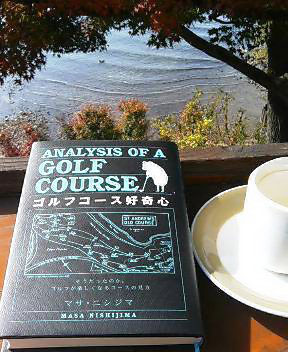
Analysis of a Golf Course by Masa Nishijima – a must have for golf architecture fans.
What Asian architects are building interesting courses these days?
In regards to world class golf in Asia, most are built from design teams from the U.S., Britain, and Australia. Asian Course designers including Japanese do not attach as much importance to landscaping and yet the landscape is one of the most important parts in developing a golf course.
You have seen Nine Bridges in Korea several times and watched as it evolves. What do you like about it?
I first visited Nine Bridges in 2000 during the course creation. I imagined it to become a large-scale tournament course in those days. I went back in 2004. Because the World Club Championship was being held, I went in as a WCC reporter of a magazine. Many people praised Nine Bridges highly. However, I did not judge it as highly as the design was too much man made. A lot of the greens were of the multi-tiered type, with sod wall bunkers and pot bunkers which was out of character with the surrounding mountains. I felt a lot of the courses built in the 1980s in America, especially in California and Florida, were of this level.
Nine Bridges was ranked 95th in the WORLD TOP 100 by GOLF Magazine in 2005, but I felt doubtful of that ranking in those days. In fact, world rankings need only be completed in the U.K., Ireland, U.S.A. and Australia if you are concerned only about the quality of the course. However, there is another purpose of World Rankings as they can help set a standard for splendid golf courses in other countries where a good golf culture does not already exist.
I joined a photographer of Choice Magazine this past April and played Nine Bridges again, and it has been newly improved. It is “Fairway Through to the Green” which was able to just connect the fairway where the one is seen in a style of Mackenzie at the green. Many of the multi-tiered greens that were obviously man made disappeared and the new green succeed in having splendid view balance. Furthermore, some holes were redesigned. Probably, they performed this renovation from the opinion of the specialists that visited Nine Bridges. They need to change the shaping of bunker on the seventeenth par-three into classic style.
For the past five years, most of the courses being designed in Korea were of the past modern American types. But now the golf course design is more Modern Classic. If Nine Bridges was to be fully renovated in the concept by modern classic, I believed that they would become true World Top 100 course.
We need to be most careful about one thing: the world’s most famous courses always carry out efforts to improve their courses. Examples include Oakmont, Cypress Point, Valley Club of Montecito, and Winged Foot.
One hundred percent of the finished goods are not in the golf course. A golf course gives us seventy percent of satisfaction, and that leaves thirty percent. Nine Bridges joined the Top 100 in the 2005. However, they have improved the thirty percent as they weren’t satisfied with it. I think their wanting to move ahead is a very splendid thing.
What is it about the thirteenth at Nine Bridges that you admire so much?
The old thirteenth was such a poor design that there is nothing left in my memory. It was converted into par three with the mound that slopes left and connects beautifully with the green. Although it is not a difficult par three, depending on a wind and pin position, one may want to lay up near the mound rather than attack the green directly. Also it is acceptable for the ball to hit the mound and roll onto the green.
It accepts various imaginative shots. There is pleasure of such golf in classic holes, be it on links or the U.S. I admire thirteen as one of the best pars threes in Asia.
What is the current building climate in Japan for new course construction?
Japan has 2,400 courses, which is a lot for a small country. Thus, I don’t expect very much new course construction in the future.
There are many courses that have been redesigned into one green from alternate greens (two greens or twin greens) in Japan. Some golf journalists that judge courses are high on this work, but I cannot think that alone makes a course magnificent.
Abnormal weather in these past several years changes the ideal grasses for golf course construction. Courses with Pen A2 and A4 grasses have increased recently in Japan. However, these Grass won’t match the Japanese climate in the future. Vast management cost will be necessary, so I think there is a lot of work to be had in getting the right grasses on some courses.
There is one course that we expect to become World Class by future re-design. It is Dai-Hakone CC in Hakone City, which is famous for its Hot Spring. It enjoys splendid topography and great terrain but its design is poor. Also it has two bent greens even though the land is large. They did not make the best use of a good point of the land. Dai-Hakone told me that they wish to ask my friend Tom Doak for redesign. I promise that if Tom redesigns Dai-Hakone, the course will be top class in the world.
How about in the rest of Asia?
What we should pay attention to is the Chinese golf population. It has only been fifteen years that golf course development has been performed in China. However, China is near to exceeding Japan in terms of number of golfers. The 230 courses that Golf Digest announced in China is already a thing of the past; there are 400 courses. Because China is a socialist country, golf courses may be produced indefinitely. All the Chinese golf courses today enjoy a full state of play every day.
Mission Hills owns twelve courses already, and someone told me that they have another seven courses planned for the future. However, the new courses being made in China are not so interesting to me. The people involved only vaguely understand golf course design, which is a big obstacle to convey excellent golf culture and a genuine golf course. The same thing happened in South Korea and in Japan, before the bubble economy broke fifteen years ago.
As for the Asian Tour, China will likely become the headquarters of the Asian Tour after the Beijing Olympic. It is Chinese money that is fueling the huge increase in the purses on the Asian Tour.
Excellent players are being brought up by China’s national budget, and possibly one day an Asian Tiger Woods will be born.
Asia famously has thousands and thousands of miles of coastlines. Which countries are apt to be the next hot bed for great golf courses?
I will say Vietnam. You may be surprised, but there are dunes and links land equal to Bandon Dunes in Oregon. If Doak, Coore/Crenshaw, or Kidd design a course there, an Asian Bandon Dunes may be born. It is the land of dreams.
Please describe Golden Pebble Beach. What do you think about it?
I’m sorry but it has been eight years since I inspected this course. Golden Pebble Beach was called Dailen Jin Shi GC in those days. Its location is good, but memory says the holes don’t have lasting interest. It is closer to being a so-called Holiday Course.
I think that Pine Valley (near Beijing) and Spring City, Mission Hills Norman Course, and the Chung Shan Hot Spring Nicklaus Course are golf courses of World Class in China.
Some judge Tiger Beach highly, but I cannot share that interest.
What are three hidden gem courses across Asia that you would strongly recommend visitors seek out?
I recommend Dalat Palace GC Vietnam as Hidden Gem. It is a course with splendid topography that was most suitable for a golf course. In addition, Dalat Palace has a design concept of a classic course as well. It opened in 1922 (originally a 9-hole course) by the last emperor Bao Dai.

Dalat Palace, in the highlands of Vietnam. (Photo by Shigeru Ohki)
Another is Koga GC from Japan. Course is still Alternate Greens, but Koga remodels Main Green, and the turf is mixture of Pen A2+G2, and this is the first trial in the world. The original designer of Koga was Osamu Ueda. He is the man who restored an original drawing of Allison to a base in Hirono GC after the war.
I have great expectations in the golf course development of India. In this country, the golf population is 50,000 people or less still. However, the well-to-do population in IT and investment Business is almost the same as in China. One championship course called Golden Green, which was designed by Martin Hawtree, has already been completed.
The End








